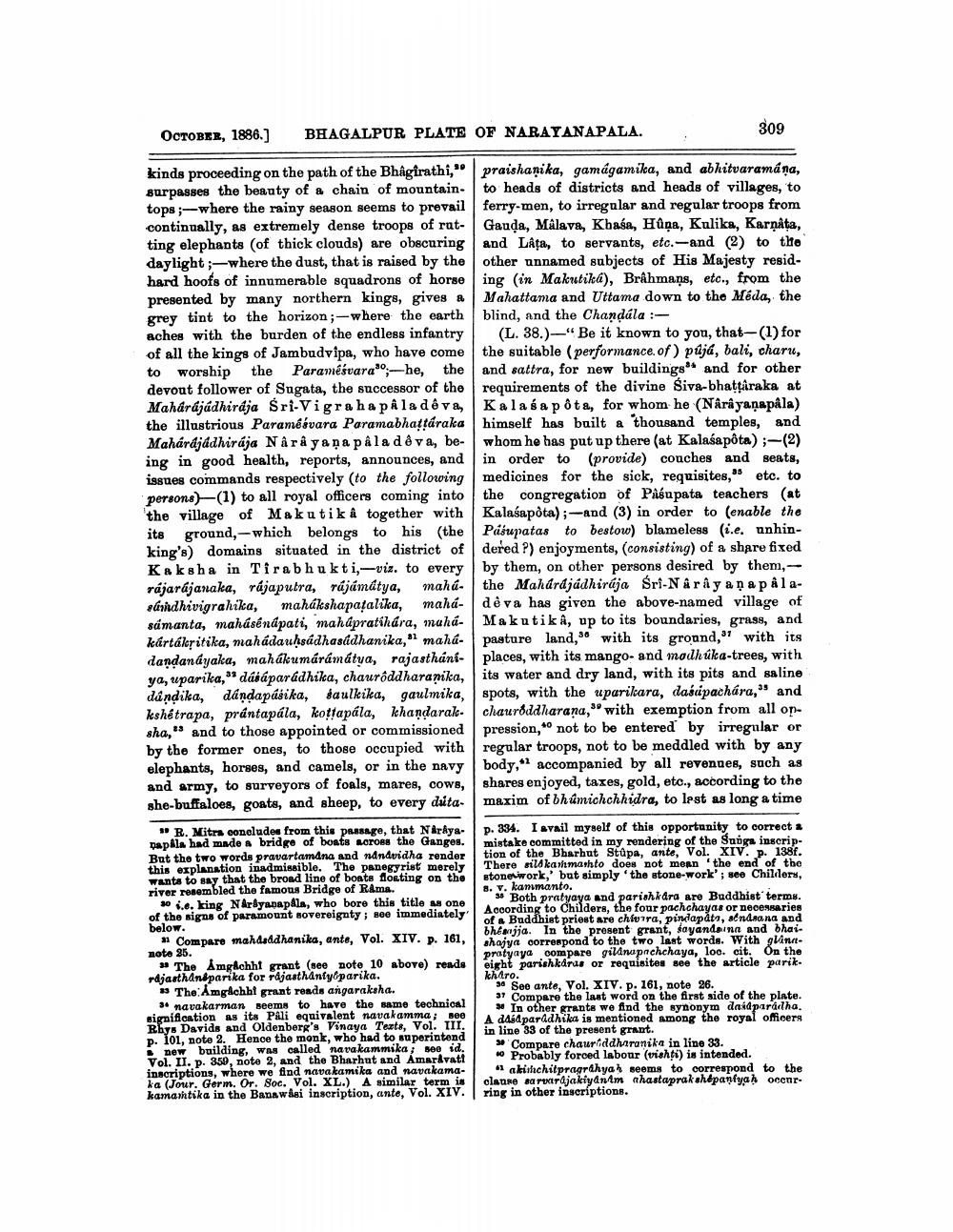________________
OCTOBER, 1886.)
BHAGALPUR PLATE OF NARAYANAPALA.
309
kinds proceeding on the path of the Bhagirathi," praishanika, gamagamika, and abhitvaramána, surpasses the beauty of a chain of mountain-| to heads of districts and heads of villages, to tops ;-where the rainy season seems to prevail ferry-men, to irregular and regular troops from continually, as extremely dense troops of rat- Gauda, Málava, Khasa, Hûņa, Kulika, Karnata, ting elephants of thick clouds) are obscuring and LAța, to servants, etc.--and (2) to the daylight ;-where the dust, that is raised by the other unnamed subjects of His Majesty residhard hoofs of innumerable squadrons of horse ing (in Makutiká), Brahmans, etc., from the presented by many northern kings, gives a | Mahattama and Uttama down to the Méda, the grey tint to the horizon ;-where the earth blind, and the Chandála :aches with the burden of the endless infantry (L. 38.)-"Be it known to you, that-(1) for of all the kings of Jambudvipa, who have come the suitable (performance. of) pdja, bali, charu, to worship the Paramésvarao;-he, the and sattra, for new buildings and for other devout follower of Sugata, the successor of the requirements of the divine Siva-bhattaraka at Maharájádhiraja Sri-Vigra ha på la déva, Kalasa pôta, for whom he (Narayanapala) the illustrious Paraméávara Paramabhattáraka himself has built a thousand temples, and Mahardjadhirája Nara yang pala d dva, be-whom he has put up there (at Kalasapôta) ;-(2) ing in good health, reports, announces, and in order to provide) couches and seats, issues commands respectively to the following medicines for the sick, requisites, etc. to persons) (1) to all royal officers coming into the congregation of Pasupata teachers (at the village of Maku tika together with Kalasapôta); -and (3) in order to enable the its ground, -which belongs to his (the Pasupatas to bestow) blameless (ie, unhinking's) domains situated in the district of dered ?) enjoyments, consisting) of a share fixed Kaksha in Tirabhukti-viz. to every by them, on other persons desired by them, rájarájanaka, rájaputra, rájámátya, mahá- the Mahardjádhiraja Śri-Náray anap alasandhivigrahika, mahákshapatalika, mahá- dè va has given the above-named village of samanta, mahásénapati, mahdpratíhára, mahá- Makutikå, up to its boundaries, grass, and kártákṣitika, mahadauhsádhasádhanika," mahá- pasture land, with its ground, with its dandanayaka, mahákumárámátya, rajasthání- places, with its mango- and modh úka-trees, with ya, uparika," dásáparádhika, chaurôddharanika, its water and dry land, with its pits and saline dåndika, dándapásika, Saulkika, gaulmika, spots, with the uparikara, dasápachára," and kshetrapa, prántapála, kottapala, khandaral. chaurddharana," with exemption from all onsha," and to those appointed or commissioned pression, not to be entered by irregular or by the former ones, to those occupied with regular troops, not to be meddled with by any elephants, horses, and camels, or in the navy | body,“ accompanied by all revenues, such as and army, to surveyors of foals, mares, Cows, shares enjoyed, taxes, gold, etc., according to the she-buffaloes, goats, and sheep, to every data- maxim of bhúmichchhidra, to lest as long a time
B. Mitra concludes from this passage, that Naraya- p. 334. I avail myself of this opportunity to correcta Dapkla had made a bridge of boats across the Ganges. mistake committed in my rendering of the Sunga inscripBut the two words pravartamdna and ndndvidha render tion of the Bharhut Stúpa, ante, Vol. XIV. p. 138f. this explanation inadmissible. The panegyrist merely There wild karl marto does not mean the end of the Wants to say that the broad line of boate docting on the stonework, but simply the stone-work' ; see Childers, river resembled the famous Bridge of Rama.
8. v. kanumanto. 30 4.e. king Narbyapapala, who bore this title as one
* Both pratyaya and parishkara are Buddhist terms. of the signs of paramount sovereignty ; see immediately
According to Childers, the four pachchayas or necessaries below.
of a Buddhist priest are chiura, pindapito, andrana and * Compare mahdsadhanika, ante, Vol. XIV. p. 161,
bhajja. In the present grant, sayandainn and bhai.
shajya correspond to the two last words. With glinstnoto 35.
pratyaya compare gildnapochchaya, loc. cit. On the » The Amghchht grant (see note 10 above) reads eight parishkrus or requisites see the article parik. rdjasthanaparika for rajasthantyparika.
kharo. * The Amgachht grant reads angaraksha.
- Seo ante, Vol. XIV. p. 161, note 26. navakarman seems to have the same technical
37 Compare the last word on the first side of the plate.
» In other grants we find the synonym daidparádlha. signification as its Páli equivalent navakamma; see
A dakparadhika is mentioned among the royal officers Rhys Davids and Oldenberg's Vinaya Texts, Vol. III. p. 101, note 2. Hence the monk, who had to superintend
in line 33 of the present grant. new building, was called navakammika; 600 id.
» Compare chauriddharanika in line 33. Vol. II. p. 350, note 2, and the Bharhut and Amaravat! 0 Probably forced labour (vishti) is intended. inscriptions, where we find navakamika and navakama- akinhchitpragrahyah seems to correspond to the ka (Jour. Germ. Or. Soc. Vol. XL.). A similar term is claune sarurdjakiyanim ahastaprakahepantyaḥ occur. kamamtika in the Banawasi inscription, ante, Vol. XIV. ring in other inscriptions.




